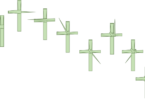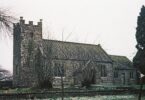Yule always will be an ancient European tradition a celebration meant for Europeans honoured for thousands and thousands of years before Christmas. We are of the north this celebration is deeply a part of our ancestral psyche. Christianity was an attempt to unify Europeans under one God and it was a violent process that’s just the reality of it over time our pre-Christian knowledge was eroded and supplanted with Christian names and faces the buried deep the truth remains it’s why we love the feeling of Christmas so much the church had to keep the main elements of pagan myth because within it lies powerful truths charged with thousands of years of accumulated ritual it’s the only way people would have accepted it there had to be something familiar and truthful within it for instance Odin he
0:54
wounded himself by a spear hung for nine
0:56
days on the world tree he uttered that
0:59
he had sacrificed himself to himself he
1:02
came back to life with knowledge and
1:04
power over the nine worlds sound
1:06
familiar
1:08
Christmas we are told that an angel
1:11
appeared to a virgin woman Mary and said
1:13
she would miraculously conceive and give
1:15
birth to a son the child would be called
1:18
Jesus the king of kings well it was
1:20
decided by Pope Julius that his birth
1:23
would be celebrated on December 25th
1:25
placing it right in line with the winter
1:27
solstice intentionally to claim it this
1:30
son Jesus would be the light and Savior
1:33
of the world the Son of God the light of
1:35
the world the risen Savior he who will
1:38
come again Yool Yool a 12 Day
1:44
celebration in Old Norse sounds just
1:46
like Yule and Swedish which means wheel
1:49
the wheel marks the changing seasons the
1:52
course of the Sun and the cycle of life
1:54
the Sun cross or Sun wheel is an ancient
1:57
European symbol that’s why burning a
2:00
giant Sun wheel as a Yule tradition one
2:02
to start doing again the female aspect
2:05
of Christmas is important Mary gives
2:08
birth to a son in the Nordic story of
2:11
Yule the
2:12
a goddess Frigg the wife of Odin is
2:14
associated with fertility marriage
2:17
household and motherhood Frigg has her
2:20
own Palace where she sits spinning
2:22
clouds to float above Midgard the human
2:24
world she spins the wheel of life
2:27
bringing in the new Sun the change in
2:30
season the Yule wreath is a symbol
2:33
adapted from frigg’s spinning wheel she
2:36
is also the mother of Balder the god of
2:38
light truth and peace he was considered
2:41
the most favored and best of the Gods
2:43
Balder has visions at his death and is
2:46
pierced with a spear of mistletoe like
2:48
the mistletoe we incorporate during Yule
2:50
his mother Frigg weeps over his body and
2:53
something her tears became the white
2:55
berries on the European mistletoe our
2:57
pre-christian ancestors venerated both
3:00
male and female deities and applied them
3:03
to cycles of nature in those days plants
3:06
and trees that remain green all years
3:08
seemed magical for Europeans in the
3:10
winter such as evergreen pine spruce
3:13
Holly mistletoe and ivy the plants we
3:17
associate with Christmas today every
3:20
nine years Vikings had a sacred
3:21
sacrifice to the gods called blood which
3:24
means sacrifice worship many gathered
3:27
from around to offer their gifts to the
3:29
gods in exchange for blessings and
3:31
fertility sustenance and protection
3:34
after sacrificially taking the life of
3:36
an animal they would be hung from holy
3:39
trees and a sacred grove the blood would
3:42
drip from the trees you know the red
3:44
Yule Ball ornaments you hang from the
3:46
tree they’re symbolic of the drops of
3:49
blood or pieces of flesh
3:51
given to the gods but what about Santa
3:53
or Saint Nick on the night of Yule the
3:56
bearded
3:57
Odin leads a great hunting party riding
3:59
his fierce eight-legged horse named
4:01
slate nerd he leads a band of horsemen
4:04
and hounds and a hunt through the night
4:06
sky on that night children usually
4:08
placed boots filled with hay outside
4:11
their doors to feed sleep nur Odin would
4:13
leave a gift in return that’s why we
4:16
hang stockings on the mantel some
4:18
countries still filled the socks with
4:20
hay and in Norse myths the gods like
4:22
gifts hence the cookie and milk for
4:25
Santa
4:25
Thor the God of Thunder and lightning
4:27
rode a chariot pulled by two goats two
4:30
of Santa’s reindeer are named Donner and
4:32
Blitzen Donner means thunder and German
4:34
Blitzen means lightning in English this
4:36
is a reference to Thor and his goats
4:38
Santa is Odin a magical God and a wise
4:42
shaman keith’s
4:43
today leave a cookie for Santa no
4:45
different than Vikings leaving a gift to
4:47
their gods of course to the church this
4:50
wise ancestor we call Santa is Satan
4:53
elves like Santa’s helpers are very much
4:56
from Germanic Norse myths one of the
4:58
nine worlds is called Alfheim the home
5:01
of light elves they aren’t gods but they
5:04
possess magical powers and skills winter
5:07
solstice their rebirth of the Sun well
5:10
so did ancient Europeans we had deities
5:12
for all things in nature the Sun is the
Saviour of the world especially when you
live in the cold north but the deities
5:20
that arose from the collective psyche of
5:23
our European ancestors are also
5:25
communicating the inner cycle of birth
5:28
death and resurrection mule is both
5:31
inner and outer we are tied in with the
5:34
Earth’s cycles which affect us
5:36
internally and externally our ancestors
5:40
knew this to be cut off from this is to
5:43
be dead the winter solstice marks an
5:45
important turning point the shortest day
5:47
of the year and the longest night of the
5:49
year which means the next days will be
5:51
lighter longer an increase in the hours
5:54
of daylight until the summer solstice
5:56
and if you lived through a northern
5:58
winter you’d understand why this turning
6:01
point of more daylight is so cherished
6:03
and venerated it’s the equivalent of
6:05
passing through the dark night of the
6:07
soul you might already know this but
6:10
even the days of the week come from the
6:12
Norse this Christmas falls on Friday
6:14
free dog and Swedish which comes from
6:17
Freya and Frigg the Norse goddesses it’s
6:20
time to reclaim your true culture
6:22
holidays myths rituals and values reject
6:26
the fake copy that is giving you a
6:28
watered-down version of the truth
cutting you off from connecting to your
line your people and your grounding.
Many have suggested that there are serious connections between the Christian celebration of Christmas and the Roman celebrations of their pagan gods, particularly Sol Invictus and Saturnalia. Is there truth to this? Why was December 25 chosen by Christians to commemorate Jesus’ birth?







